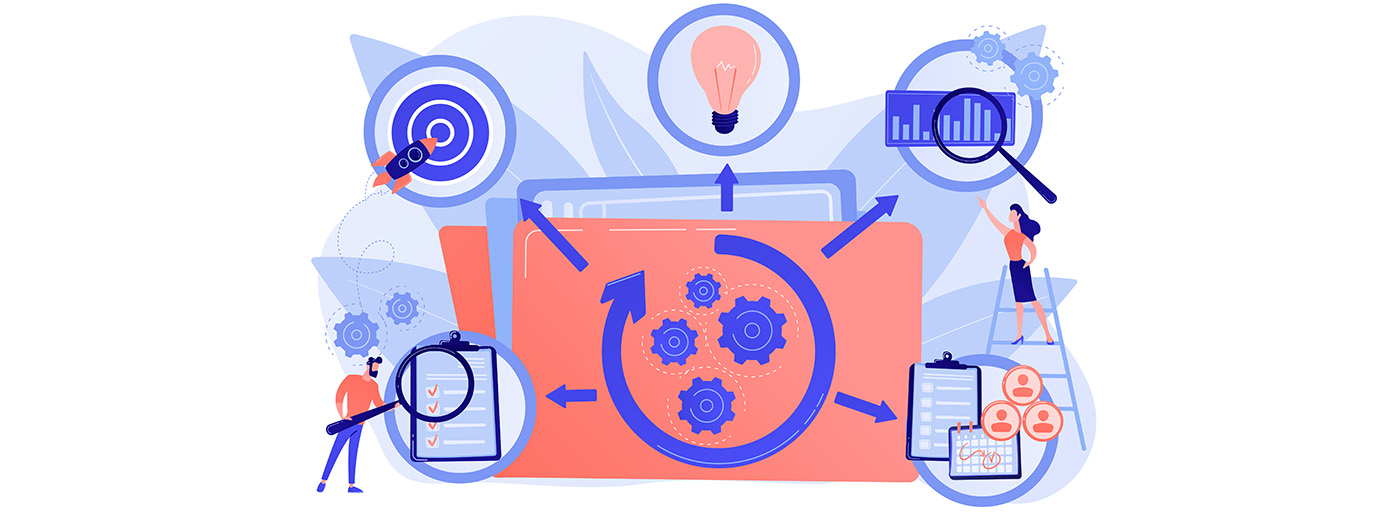Examples of KPI in Marketing – What to Track to Succeed
In 2021 there is enormous competitiveness among business offers; therefore it’s essential to know how to manage all processes, analyze and plan your growth. Don’t know how to cope with it and what to start from? First, let’s have a brief overview of what are examples of KPI in marketing. Second, we offer you to consider the difference between indicators for a website, eCommerce site, and information site, and how to act depending on it.
KPI for Marketing Campaign
All our actions have consequences, and it’s obvious that to achieve better results, it’s essential to have goals and effective strategies. Thus, key performance indicators help monitor, analyze and measure the success of some marketing activities and decide where to transmit the budget. In case you want to track the performance of a specific project or your business development, undoubtedly, you need to learn the actual examples of KPI in marketing and define the ones that work for you.
Why KPI Digital Marketing Is Essential

Opportunities you get:
- View of your goals, strategy, and route
- Analysis of the effectiveness of advertising channels
- Assessment of work results and the degree of goals achievement
- Adjusting your internet marketing strategy
- Forecasting budgets
Benefits you can enjoy:
- Increased work efficiency – it is easier for employees to prioritize the tasks.
- Understand problem processes.
- Growth in motivation – payment based on crucial metrics provides fair performance rewards.
Still, not every indicator can be a KPI that fits your project. To determine value, please follow this principle: KPI in marketing reflects the specific result and effectiveness of efforts that correlate with the business’s strategic goals. If you choose the wrong metrics, you risk losing focus and spending a lot of time on analytics and reporting, with minimal impact on the bottom line.
Also, there is no reason to check the things you can’t impact or change. So, it would help if you defined your must-track KPI for digital marketing. For example, we track mainly such KPIs as quality keywords, organic traffic, and the number of registered demo versions of templates for our blog campaign.
Easy Scheme of Working with KPIs
- Select key indicators and collect them in one table.
- Identify problem areas – these can be low conversions, abandoned carts, etc.
- Form specific tasks with a limited time frame – reduce the number of abandoned forms two times in three months, reduce the failure rate to 15% in 6 months, etc.
- Make a list of options for each task, and appoint performers. For example, to reduce the cost of attracting one client, you need to evaluate the current advertising channels, exclude ineffective and expensive ones, and direct the flow of funds and efforts to what can bring results.
- Measure and adjust it after the task is completed.
Lead Generation Examples of KPI in Marketing

At this point, you should monitor the following examples of KPI in marketing:
- The number of new customers.
- The number of leads(contact information you get from potential customers). It is usually divided into marketing(interest in the brand) and sales leads(interest in buying a product/service from a brand)
- Cost per lead. It’s about the amount of money spent on receiving a new lead. If you take your budget sum and divide it by the number of leads, you’ll get the cost per lead.
- Cost of Customer Acquisition. With this metric, you understand how much money you should spend to convert a potential lead to a customer. To get the results in percent, divide your budget by the number of new customers.
- ROI. Return on investment indicator/advertising payback indicator shows the ratio of profit (loss) and investment. Calculated as total revenue divided by marketing costs and multiplied by 100%. This approach is used to define the efficiency of your strategies. It’s essential to check your ROI on different marketing channels and find out which one works better, and therefore spend more money on effective decisions. For example, if you did SEO optimization that cost you 400$ and made 700$ in revenue, your ROI would be 75%.
Cost per Conversion
It considers the money you spend to get a conversion. To calculate it, you need to divide the budget by the number of conversions:
- CPV (Cost Per Visitor) – the cost of attracting one visitor. The costs are divided by the number of users attracted.
- CPC (Cost Per Click) – the cost of a click on an ad. Costs are divided by the number of clicks and used to measure the effectiveness of contextual, targeted, and display ads.
- CPO (Cost Per Order) – the cost of placing one order. It is calculated by dividing advertising costs by the number of closed deals.
- CPL (Cost Per Lead). It is defined as the ratio of ad spend per channel to the number of leads over a certain period of time.
- Return Visitor Ratio – shows how many people have returned to the site. It allows you to assess the interest in the site from users – the higher the percentage of returns, the better. It is calculated by dividing the number of repeat visits by the total number of visitors.
- LTV (LifeTime Value) is all the company’s profit that it received from cooperation with the buyer. The cost of attracting and retaining it is deducted from the amount of income from the client. This indicator can only be calculated for regular customers.
- Sales Growth. It helps to define sales changes and track whether you outperform your targets or run behind schedule.
SEO KPIs:

If SEO optimization works, there won’t be problems. However, it’s better to pay attention to:
- A number of backlinks and referral site traffic. Thus, you monitor what sites link to your pages and where your web visitors come from.
- Conversion rate. It’s the percentage of the total number of visitors who performed the targeted action. This can be sending a form, ordering, requesting a callback, purchasing, moving an item to the cart, etc. It helps assess the effectiveness of an advertising channel and is calculated by dividing conversion visits by the total number of visits and multiplying by 100%.
- Organic site traffic. The visitors who go to your site through organic search provide organic traffic.
- Load time. According to Google core web vitals, the excellent page loading speed is less than 2.5 seconds.
- Bounce rate. With its help, you track how long customers use your site and whether they go to other pages. If they leave the site even without scrolling, it’s high time to change the marketing campaign.
- Search Rankings. This KPI is used to determine what place you take on search engine results pages and whether the keyword you’ve chosen works.
Social Media Examples of KPI in Marketing
- Social Traffic.
It’s the traffic you get from social media accounts. Thus, you can track the followers who go to your site via the links in social networks.
- Follower Growth.
Nowadays, it’s essential to use all possible channels to increase your brand awareness and boost sales. Social networks aren’t an exception. You should optimize your content to attract more followers and track their growth.
- Social Shares.
Social media engagement is crucial. Therefore business owners should track how many times their content is shared and analyze strategies. Also, it’s beneficial to check the number of likes, tags, comments, messages, subscribers.
Read more: Social media marketing plan – sample, templates, and overall guidelines.
Examples of KPI in Marketing Considering the Kind of Site
The efficiency of the online store, corporate website, and information portal is determined by using different KPIs. Each resource has its own goals, and KPIs change depending on them. Below are examples of KPIs for different types of internet businesses.
eCommerce Website
Analysis of the effectiveness of an online store is impossible without the use of KPIs. There are two steps to success.
What to Pay Attention First
First, it’s necessary to determine the effectiveness of the implementation of the assigned tasks. For example, if you want to reduce the bounce rate by 15% within half a year, you’ll need the following examples of KPI:
- Bounce rate.
- Cost per click indicator should be taken into account. After all, it is of great importance what price you have to pay to complete the task.
If you aim to increase the average bill by 20% over the year, check these KPIs for the task:
- AOV (average bill).
- CPO (cost per order) – you need to take into account the CPO indicator. If it’s more than AOV, it means that all the activities to increase the average check did not make sense because, as a result, the store began to earn less.
What to Consider Constantly
The second step is to check performance indicators that are measured and analyzed constantly, regardless of the tasks set.
- CR (conversion rate) is the most critical KPI that allows you to calculate the effectiveness of an online store. With its help, you can determine how efficiently your site is performing and how convenient it is for visitors. The average CR for each niche of goods is different.
- AOV (Average Check) is an essential indicator that you should always strive to increase.
- CPO (order price) – by analyzing the CPO for different traffic sources, you can understand which one is the most profitable.
- Purchase abandonment rate is the percentage of orders that did not complete with payment. The refusal rate indicator is worth paying special attention to. In most cases, this indicator can be easily increased, thereby increasing the profitability of the business.
Besides, to understand at what stage and how many customers are interrupting the purchase process, you need to use Google Analytics. In its settings, you need to select a goal in the form of a paid order and steps towards the goal (adding an item to the cart, filling in the shipping information, entering payment information, etc.).
KPI of the Corporate Website
The main task of a corporate website is to share its ideology, vision and mission statement, to share the advantages of the company and its products.

The actual examples of KPI in marketing for a corporate website:
- Total traffic
- CPL (cost per lead)
- CR (conversion rate)
- Bounce Rate
- Number of views on the “About company” page
- The number of messages sent through the feedback form and subscriptions
For corporate websites, the total amount of traffic is the most significant of all the above KPIs. Moreover, most of these sites are focused on reaching the target audience of the company as much as possible. Google Analytics allows you to find out the total amount of traffic to the site for the reporting period and determine its sources.
KPI for Information Portal
The main task of each information portal is to provide the user with the necessary information. Have a look at the most important performance indicators of an information portal:
- Traffic
- Depth of view
- Number of comments
- Returns rate
Of all the examples of KPI in marketing, the most important are overall traffic and view depth because most information portals make money from displaying user ads. Accordingly, the more pages with advertising a user opens, the more the site will earn.
Using the Google Analytics service, you can determine the depth of your browsing. It is displayed in the “Pages / Session” metric.
All in all, we’ve learned what is KPI digital marketing, considered almost all examples, and found out where it’s better to use them. Now you know what to start from, how to analyze your business strategies and how to increase your conversion rate.




Leave a Reply